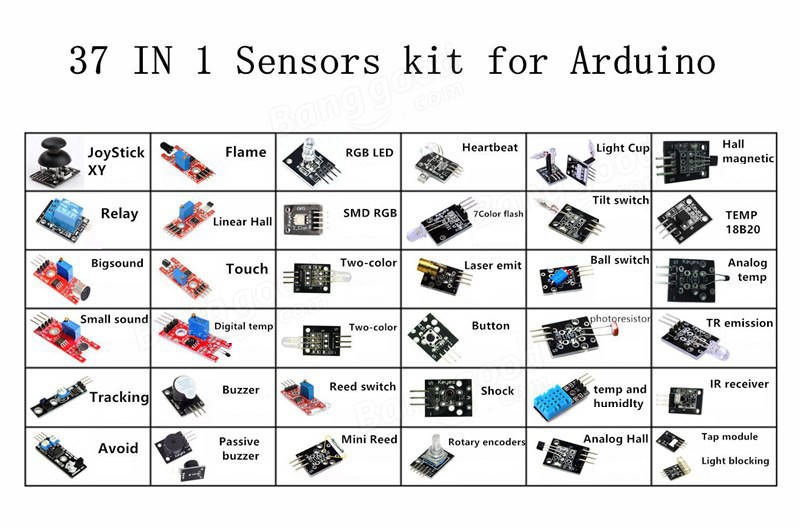Arduno neeeds sensors. Geekcreit® 37 In 1 Sensor Module Board Set Kit For Arduino Plastic Bag Package promises to give many sensors cheaply. That kit says that t contains 37 sensors. Actually it has 37 items, but not all of them are sensors (there are buzzer, relay, LED etc.). It is cheapest kit on the net with this many sensors, it would be a great value if the sensors are of decent quality. It has a good selection of sensors and indicators.
1 x Active buzzer module
1 x Passive buzzer module
1 x Common cathode RED&GREEN LED module
1 x Two color common cathode LED module
1 x Knock sensor module
1 x Shock switch sensor module
1 x Photo resistor sensor module
1 x Push button module
1 x Tilt switch module
1 x RGB LED module
1 x Infrared transmit module
1 x RGB colorful LED module
1 x Hydrargyrum switch sensor module
1 x Colorful auto flash module
1 x Magnet-ring sensor module
1 x Hall sensor module
1 x Infrared receive sensor module
1 x Analogy hall sensor module
1 x Magic ring module
1 x Rotate encode module
1 x Light break sensor module
1 x Finger pulse sensor module
1 x Magnetic spring module
1 x Obstacle avoidance sensor module
1 x Tracking sensor module
1 x Microphone sensor module
1 x Laser transmit module
1 x Relay module
1 x Analog temperature sensor module
1 x 18b20 temperature sensor module
1 x Digital temperature sensor module
1 x Linear hall Sensor module
1 x Flame sensor module
1 x High sensitive voice sensor module
1 x Humidity sensor module
1 x Joystick PS2 module
1 x Touch sensor module
I have only done some little testing with some of those sensors, but here are my first previews of the kit:
Pros:
Very many sensors cheaply (37 for $10-15)
Good value for the money, A lot of sensors you cant make them yourself for that price
Great values for money.
It is a very complete kit which will give me hours of fun for you figure out what each does!
Cons:
I got all items some pins were bent but not that big a deal.
The solder quality can be better, but for someone who can handle a soldering iron it is no problem to put the components better on the module-boards. Without the improvements, the module-boards will also work.
Lack of documentation: Good set of sensors but there is no information for pins and usage. There are no marking on boards to tell you what they are. Takes some head scratching to figure out what is what.
It is “compatible”, but not completely “plug and play”. You need at least some jumper-wires to connect them. Also you have to carefully consider the manual of the sensors to identify them and find out how to connect them – but it is not too difficult.
Warning: Old technology mercury-switches: Two of the modules contain beads of elemental (liquid) mercury contained within their tilt switches. Mercury is extremely toxic when oxidized or when vapors or byproducts are ingested. These modules are not toys.
Documentation
All sensors are compatible with Arduino but you need libraries for some of them, download and read the manual that is available now (was not available when I got the kit first). It is “compatible”, but not completely “plug and play”. You need at least some jumper-wires,and preferably a prototyping or breadboard is recommendable. Product page has now downloadable .rar packet of documentation.
View also the following documentations:
http://www.instructables.com/id/Arduino-37-in-1-Sensors-Kit-Explained/
https://www.jaycar.co.nz/medias/sys_master/images/8922936410142/XC4288-manualMain.pdf
You can use many of them also with other development boards like Raspberry Pi or ESP8266 etc, but need to consider yourself that which of them work with 3.3V also and which operate only with5V I/O only (may need to add level converters).

1 Comment
Tomi Engdahl says:
Related posting:
Arduino sensors interfacing
http://www.epanorama.net/newepa/2016/02/20/arduino-sensors-interfacing/